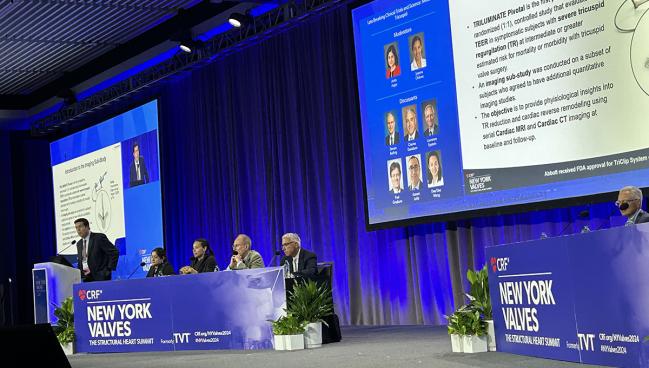T-TEER for Tricuspid Regurgitation Induces Reverse Remodeling, Works in Tricky Anatomies
Proving physical changes to the right heart emphasizes “that TR patients need to be treated,” Dee Dee Wang says.

NEW YORK, NY—In patients with symptomatic severe tricuspid regurgitation (TR), the reduction in TR seen with transcatheter edge-to-edge repair (TEER) using the TriClip system (Abbott) is associated with reverse remodeling of the right heart, according to an imaging substudy of the TRILUMINATE Pivotal trial.
Serial cardiac MRI and CT revealed that adverse changes in right heart structure and deficits in function associated with severe TR at baseline were improved significantly in the year following the procedure, with greater gains seen among those who had the largest reductions in TR, João Cavalcante, MD (Allina Health Minneapolis Heart Institute, MN), reported here at New York Valves 2024, previously known as the TVT meeting.
“The quantification that is capable . . . through the lens of cardiac MRI is very important to provide us a physiological understanding of how this therapy will affect the remodeling and eventually the outcomes of these patients,” Cavalcante said.
Another presentation during the same late-breaking clinical trial session demonstrated that T-TEER with TriClip remains beneficial even among patients with tricky anatomies, including four or more tricuspid leaflets, presence of a right ventricular device lead (but with minimal leaflet impingement), and large coaptation gaps.
Commenting on the findings for TCTMD, Dee Dee Wang, MD (Wayne State University School of Medicine, Detroit, MI), noted that it’s becoming clear that there are limitations regarding what two-dimensional echocardiography can reveal. The reverse remodeling in the right heart observed in the TRILUMINATE Pivotal imaging substudy cannot be seen on echo, “but by cardiac MRI and cardiac CT, they were able to actually identify this,” she explained, adding that “it was a wish and a hope” that such changes would occur.
That’s powerful information that shows “there’s actually more than just symptomatic relief for these patients,” Wang said. “There’s positive remodeling of the right heart, and that’s impactful because we weren’t aware of that before, because we couldn’t see it on 2D echo, so knowing that that exists gives us more promise that there’s reason to treat tricuspid regurgitation.”
Digging Deeper With Multimodality Imaging
The TRILUMINATE Pivotal trial randomized patients with symptomatic severe TR to T-TEER plus medical therapy or medical therapy alone, with the main results showing that the intervention was superior on a primary composite outcome consisting of all-cause death or tricuspid valve surgery; hospitalization for heart failure; and improvement in quality of life (QoL) according to the Kansas City Cardiomyopathy Questionnaire (KCCQ). The benefits were driven by the QoL improvement, with no differences in rates of death and heart failure hospitalization at 1 year. Those results supported US Food and Drug Administration approval of the device in April 2024.
As part of the trial, the FDA mandated the imaging substudy, which included 93 patients (mean age 78.6 years; 55.9% women) from 10 US sites. The investigators performed MRI and CT at baseline and 30 days and then CT at 12 months. Overall, the substudy included 171 MRIs and 231 CTs.
From baseline to 30 days, TR volume on MRI didn’t change significantly in the patients treated with medical therapy alone, but it was significantly reduced with T-TEER, falling from a mean of 50 to 18 mL (P < 0.0001). Patients with the largest reductions saw the greatest beneficial changes in RV size and function, Cavalcante reported.
TriClip Across a Range of Anatomies
Cavalcante’s presentation was preceded by one by Brian Whisenant, MD (Intermountain Medical Center Heart Institute, Salt Lake City, Utah), who showed meeting attendees data on the safety and efficacy of the latest-generation TriClip G4 system among TRILUMINATE Pivotal participants with challenging anatomies.
The analysis focused on 197 patients from the randomized part of the trial—who a case selection committee determined had a high likelihood of achieving moderate or less TR with the intervention—and 119 from the single-arm registry created for patients thought to have a low likelihood of meeting that threshold but a high likelihood of achieving a TR reduction of one grade. The mean age of these 316 patients was 78, and 61% were women.
Whisenant zeroed in on three challenging anatomies:
- Presence of an RV device lead (29%)
- Coaptation gaps of 7 mm or greater (43%)
- Four or more tricuspid valve leaflets (57%)
The TriClip procedure was safe across these three groups, Whisenant reported.
T-TEER reduced TR to grade 2 or less in 78% to 87% of these patients, with the lowest figure seen in patients with large coaptation gaps, a group who were most likely to have torrential TR at baseline.
Nevertheless, effects on symptoms and QoL were consistent across the range of anatomies. NYHA class I/II symptoms were achieved by 30 days in 81% to 84%, and the average increase in KCCQ score ranged from 18 to 21 points.
“The TriClip G4 system continues to demonstrate a high safety profile,” Whisenant said, noting that most TriClip patients achieved moderate or less residual TR across these anatomical groups. “Future work will help identify the characteristics of the subset of patients who do not achieve” this benchmark.
Paul Grayburn, MD (Baylor Scott & White, The Heart Hospital, Plano, TX), discussing the results after Whisenant’s presentation, said they were encouraging—but he had some caveats.
First, all of these patients, even those with challenging anatomies, were selected by the investigators because there was a high likelihood of a good result. And second, there’s a lack of information on how these patients will fare over the longer term. “Back in the day, when we were doing MitraClips with a drive-by on the tricuspid, we would get good results early and then the patients at a year or two had more TR,” Grayburn said.
Whisenant pointed out that this trial was the initial learning experience for almost all of the operators and that changes have since been made—such as the introduction of intracardiac echo—to improve the procedure. “I think this was a great success for an initial trial . . . but we’re only going to get better from here,” he predicted.
Moving Forward With TriClip
Wang said that she wishes an imaging substudy of the type reported by Cavalcante could have been performed for the COAPT trial evaluating TEER for mitral regurgitation, indicating that the additional insights would have been helpful. “What we understand now as a community is that there is added value to using everything that we have in technology to understand a device therapy and if it is truly helping a patient’s body or not,” she said.
In the case of patients with severe TR, she said, evidence that TEER is improving the heart physically “pushes the needle forward for . . . continuation of the innovation” in this field.
Whisenant’s presentation was important, Wang said, in showing that different leaflet morphologies, which in the past might have precluded a patient from being treated, respond well to T-TEER. “Our imaging understanding is still beginning, and we have to be open to learning more and more,” she stressed.
Moreover, these findings from the TRILUMINATE PIVOTAL trial provide new fodder to discussions around the lack of an impact on hard clinical endpoints, which some saw as a weakness of the study. In that context, “this is actually a step forward,” Wang said, saying that the results indicate that it might be a better idea to use right heart outcomes rather than left heart outcomes when assessing the impact of treatment.
In the absence of data, Wang explained, it's not clear whether the reverse remodeling in the right heart observed here will have a significant impact on outcomes like mortality or heart failure hospitalization over the longer term, as has been seen with similar changes in the left side of the heart.
But for now, the improvements observed in symptoms, function, quality of life, and right heart structure and function are enough to encourage treatment of these patients with TriClip, Wang said, underscoring that there is a need for much more research on diseases affecting the right side of the heart.
Todd Neale is the Associate News Editor for TCTMD and a Senior Medical Journalist. He got his start in journalism at …
Read Full BioSources
Cavalcante J. Impact of tricuspid regurgitation on right heart remodeling: insights from the TRILUMINATE Pivotal imaging substudy. Presented at: New York Valves 2024. June 6, 2024. New York, NY.
Whisenant B. T-TEER in a broad range of anatomies: results from the TRILUMINATE Pivotal trial. Presented at: New York Valves 2024. June 6, 2024. New York, NY.
Disclosures
- The TRILUMINATE Pivotal trial is sponsored by Abbott.
- Cavalcante reports grants/research support from Abbott Structural, the Allina Health Foundation, JenaValve, and NIH/NHLBI; honoraria/consulting fees from 4C Medical, Abbott Structural, Alleviant, Anteris, Boston Scientific, Circle Cardiovascular Imaging, Edwards Lifesciences, JenaValve, JC Medical, Medtronic, Novo Nordisk, Pie Medical, Siemens Healthineers, Shockwave, and Zoll; and stock in MyCardium AI.
- Whisenant reports consulting fees/honoraria from Abbott Medical and Edwards Lifesciences.
- Wang reports consulting or speaking fees or honoraria from Abbott Vascular, Boston Scientific, Edwards Lifesciences, and Materialise and grant support/research contracts from Boston Scientific.





Comments